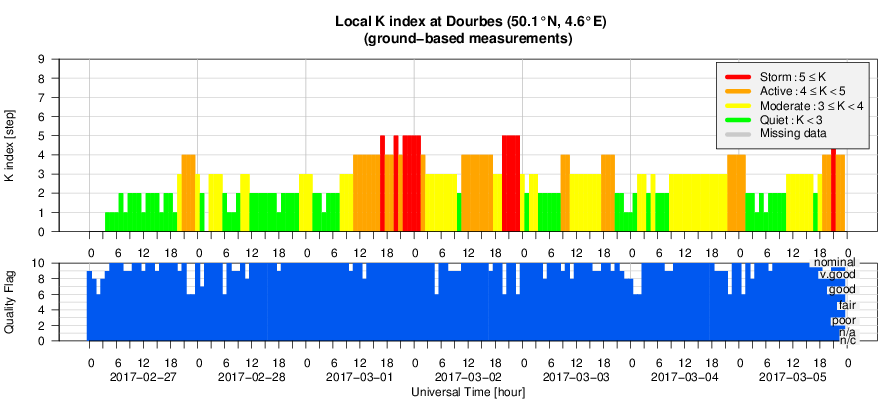- Table of Content
- 1.ESWW14 news
- 2.Topical Issue ...
- 3.The STCE in 20...
- 4.PROBA2 Observa...
- 5.Review of sola...
- 6.The Internatio...
- 7.Geomagnetic Ob...
- 8.Review of iono...
- 9.Future Events
2. Topical Issue for the SWSC Journal
3. The STCE in 2015
4. PROBA2 Observations (27 Feb 2017 - 5 Mar 2017)
5. Review of solar and geomagnetic activity
6. The International Sunspot Number
7. Geomagnetic Observations at Dourbes (27 Feb 2017 - 5 Mar 2017)
8. Review of ionospheric activity (27 Feb 2017 - 5 Mar 2017)
9. Future Events
ESWW14 news
We have ESWW14 news!
ESWW14 sessions
We are proud to present the list of ESWW14 sessions. And, you can already submit an abstract: http://www.stce.be/esww14/program/sessions.php
ESWW14 and CubeSat
This year, ESWW14 running from Monday 27th November to Friday 1st December is co-located with the 9th European CubeSat Symposium (9ECS) that runs from Wednesday 29th November to Friday 1st December.
One Ticket for Two Conferences.
ESWW14 participants can attend ALL the CubeSat activities and CubeSat participants can attend ALL the ESWW14 activities. A bargain. http://www.stce.be/esww14/CubeSat.php
ESWW14 and CubeSat Registration
For the early birds, registration is already open: http://www.stce.be/esww14/registration.php
Stay tuned
More to come in the near future: fair, exhibition, topical discussion meetings, special activities ....
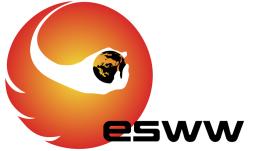
Topical Issue for the SWSC Journal
Benefiting from the highly successful ESWW13 (http://www.stce.be/esww13/ ), the open-access Journal of Space Weather and Space Climate (SWSC, http://www.swsc-journal.org/ ) has opened a new topical issue (TI).
Space weather effects on GNSS and their mitigation
Link to scope and guidelines: http://www.swsc-journal.org/component/content/article/11-news/267-topical-issue-space-weather-effects-on-gnss-and-their-mitigation-deadline-15-june-2017
The Topical Editors-in-Chief are Jens Berdermann (jens.berdermann@dlr.de ) and Claudia Borries (claudia.borries@dlr.de ).
Deadline for submission: 15 June 2017
Questions regarding this TI can be addressed to the topical editors-in-chief. For questions concerning the submission process, please contact the Editorial Office (swsc@edpsciences.org ). Manuscripts have to be submitted in PDF format via the SWSC online submission tool (https://articlestatus.edpsciences.org/is/swsc/ ) before the deadline.
This TI is completely open to all contributors, i.e. it is NOT limited to ESWW13 conference participants.
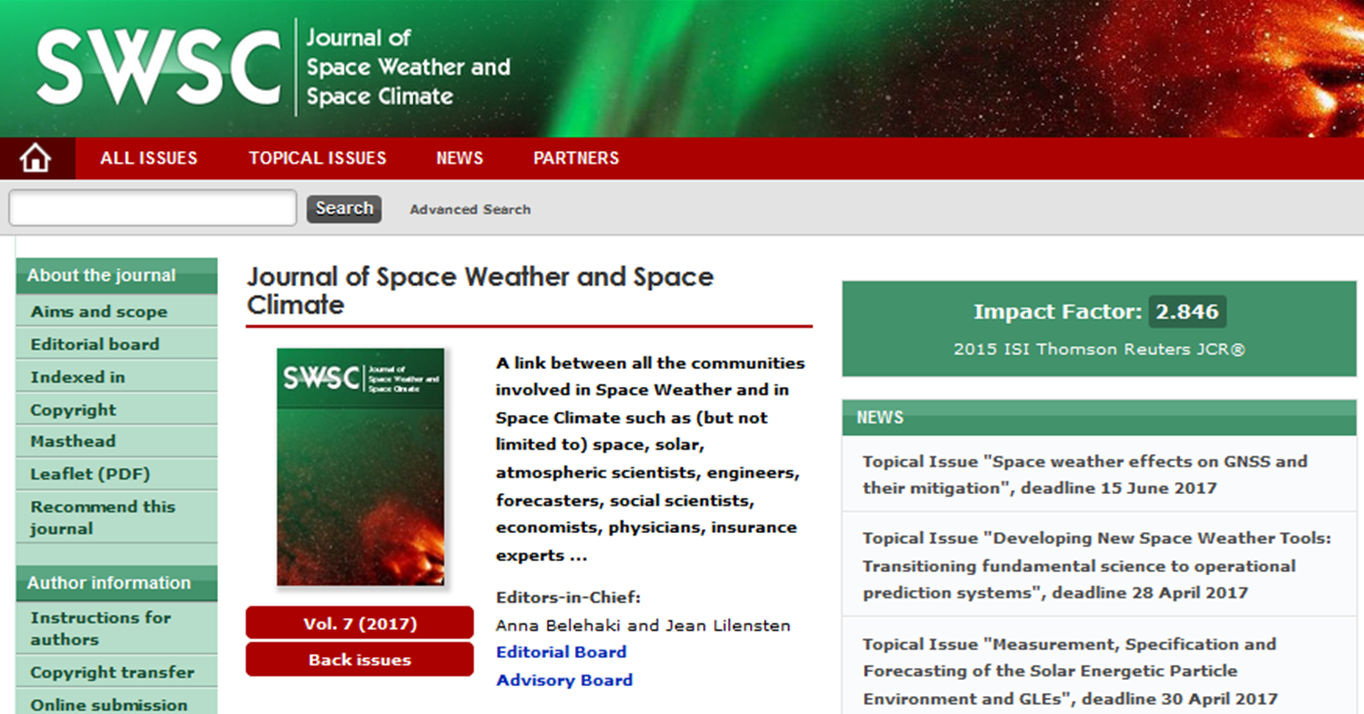
The STCE in 2015
The STCE Annual Report 2015 is now available at http://www.spaceweather.eu/en/repository/show?id=619
It is a compilation of the activities done in 2015 within the frame of the Solar-Terrestrial Centre of Excellence (STCE). This report continues the style from the previous editions. Hence, as it is targeting a more general public, it presents only a selection of the 2015-activities in easy-to-digest summaries. These summaries emphasize the intense collaboration between the institutes at the Space Pole, as well as with our external partners. We hope you enjoy this report, which features articles on solar and space weather activity, the 12th European Space Weather Week, the new sunspot number, water vapour content, the 20 March solar eclipse, solar views with jHelioviewer, HELCATS, nano-satellites, and much more...
We wish you an enjoyable reading experience and a safe trip home!
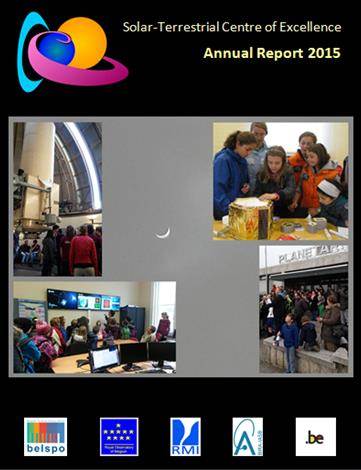
PROBA2 Observations (27 Feb 2017 - 5 Mar 2017)
Solar Activity
Solar flare activity was very low during the week.
In order to view the activity of this week in more detail, we suggest to go to the following website from which all the daily (normal and difference) movies can be accessed: http://proba2.oma.be/ssa
This page also lists the recorded flaring events.
A weekly overview movie can be found here (SWAP week 362).
http://proba2.oma.be/swap/data/mpg/movies/weekly_movies/weekly_movie_2017_02_27.mp4
Details about some of this week’s events, can be found further below.
If any of the linked movies are unavailable they can be found in the P2SC movie repository here
http://proba2.oma.be/swap/data/mpg/movies/
Monday Feb 27
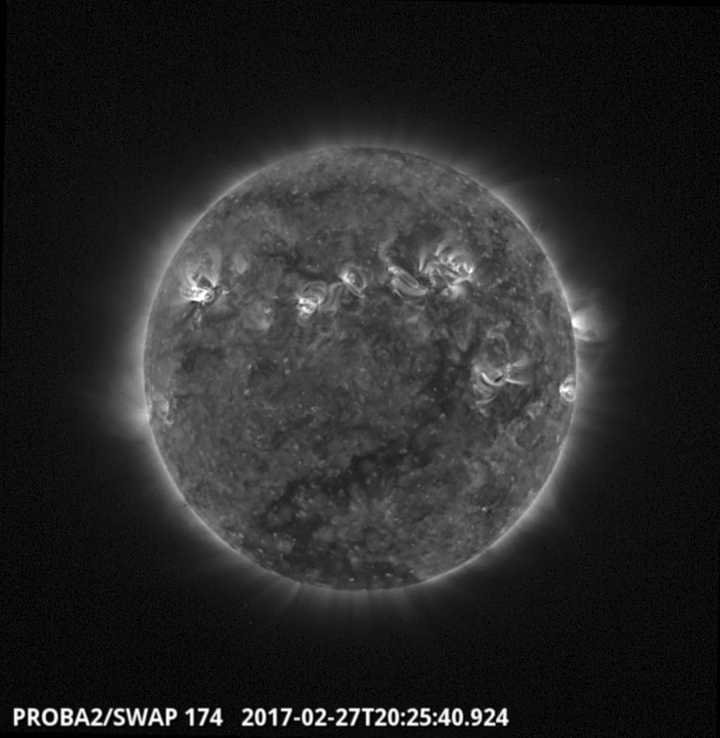
AR 2641 produced the strongest flare of the week on 2017-Feb-27 at 20:25 UT (a B9.3). This active region is visible above in the North-East part of the Sun.
Find a movie of the events here(SWAP movie)
http://proba2.oma.be/swap/data/mpg/movies/20170227_swap_movie.mp4

A trans-equatorial coronal hole, which produced enhanced geomagnetic conditions at the Earth, was seen on the solar disk at the beginning of the week. This can be seen in the above SWAP image.
Find a movie of the events here(SWAP movie)
http://proba2.oma.be/swap/data/mpg/movies/20170227_swap_movie.mp4
Sunday Mar 05
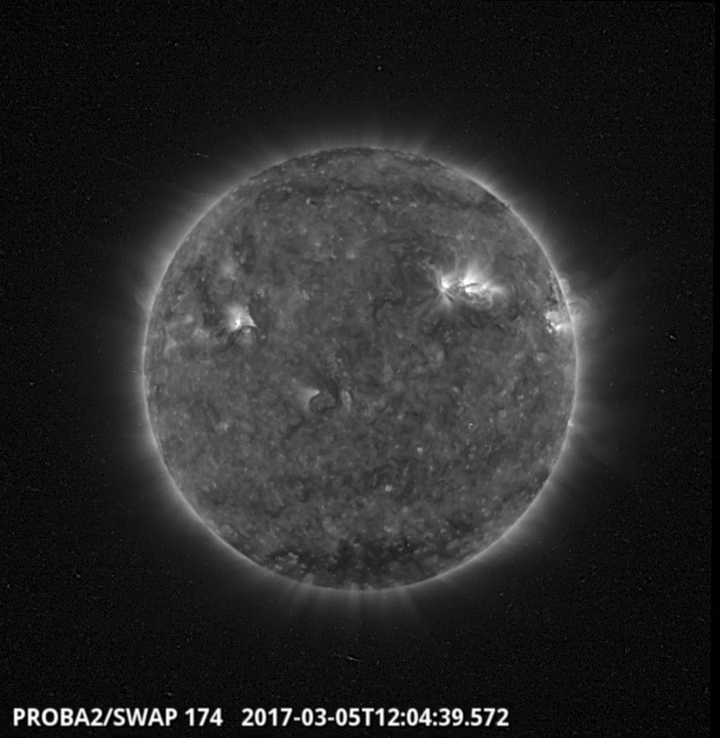
A transient coronal dimming produced from a bipolar, spotless region
near N05E30 occurred around 2017-Mar-5 at12:00UT and can be seen in the above SWAP image and the linked SWAP movie below.
Find a movie of the event here(SWAP movie)
http://proba2.oma.be/swap/data/mpg/movies/20170305_swap_movie.mp4
Review of solar and geomagnetic activity
Solar Activity
Solar activity was very low. NOAA 2641 produced the strongest flare of the period: a B9.3 flare on 27 February. The solar disk was nearly spotless by the end of the period. Some coronal dimming in a bipolar, spotless region near N05E30 occurred around 5 March/12:00UT and was followed an hour later by a faint coronal wave to the south and west. No x-ray flare was related. to the event. The associated coronal mass ejection was slow and diffuse and seems to be directed mostly to the south and east of the Earth. The greater than 10MeV proton flux was at nominal levels. A small positive coronal hole (CH) was at the Central Meridian on 2 March, but had fully closed by early 5 March.
Geomagnetic Activity
Solar wind conditions near Earth were determined by the high speed stream (HSS) from the trans-equatorial extension from the negative southern polar coronal hole (CH). The co-rotating interaction region (CIR) that preceded it arrived on 1 March, with the proper HSS arriving early on 2 March and influencing the earth environment until the end of the period. Solar wind speed gradually increased from an initial 400 km/s to peak values near 740 km/s, ending the week with values near 650 km/s. Bz oscillated wildly between -17 nT and +14 nT in the CIR, then mostly between -5 nT and +5 nT afterwards. Following a sector boundary crossing on 27 February, the interplanetary magnetic field was directed towards the Sun for the rest of the week.
Mostly quiet to unsettled geomagnetic conditions were observed prior to the arrival of the CIR/HSS, and mostly unsettled conditions to minor storming afterwards. A Kp of 6 was reported for a single episode on 1 March (21-24UT interval).
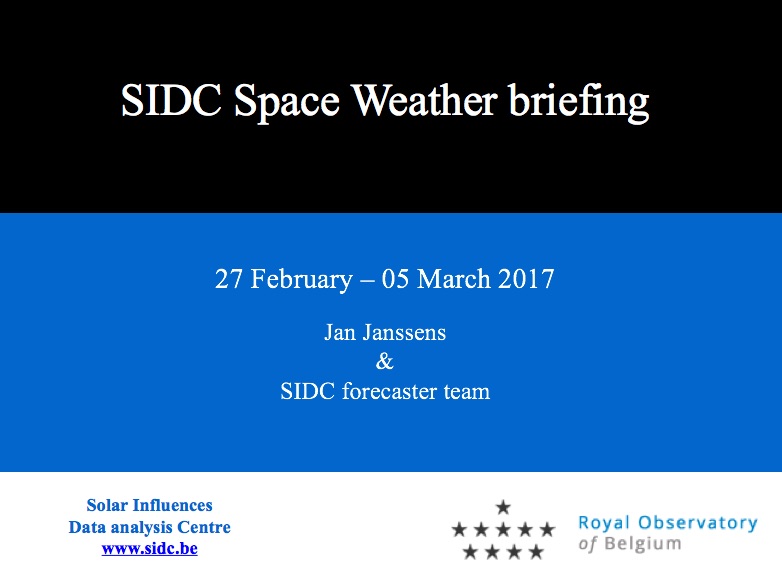
Check the briefing presentation: http://www.stce.be/movies/SIDCbriefing20170306.ppsm
The International Sunspot Number
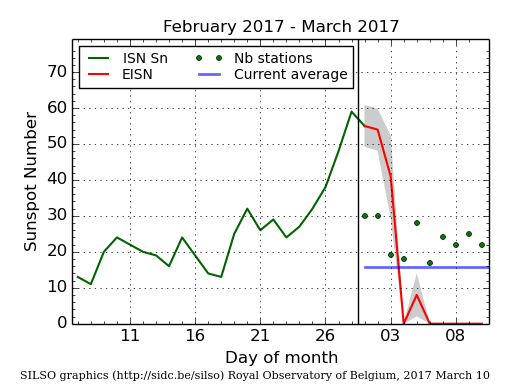
The daily Estimated International Sunspot Number (EISN, red curve with shaded error) derived by a simplified method from real-time data from the worldwide SILSO network. It extends the official Sunspot Number from the full processing of the preceding month (green line). The plot shows the last 30 days (about one solar rotation). The horizontal blue line shows the current monthly average, while the green dots give the number of stations included in the calculation of the EISN for each day.
Review of ionospheric activity (27 Feb 2017 - 5 Mar 2017)

The figure shows the time evolution of the Vertical Total Electron Content (VTEC) (in red) during the last week at three locations:
a) in the northern part of Europe(N61°, 5°E)
b) above Brussels(N50.5°, 4.5°E)
c) in the southern part of Europe(N36°, 5°E)
This figure also shows (in grey) the normal ionospheric behaviour expected based on the median VTEC from the 15 previous days.
The VTEC is expressed in TECu (with TECu=10^16 electrons per square meter) and is directly related to the signal propagation delay due to the ionosphere (in figure: delay on GPS L1 frequency).
The Sun's radiation ionizes the Earth's upper atmosphere, the ionosphere, located from about 60km to 1000km above the Earth's surface.The ionization process in the ionosphere produces ions and free electrons. These electrons perturb the propagation of the GNSS (Global Navigation Satellite System) signals by inducing a so-called ionospheric delay.
See http://stce.be/newsletter/GNSS_final.pdf for some more explanations ; for detailed information, see http://gnss.be/ionosphere_tutorial.php
Future Events
For more details, see http://www.spaceweather.eu/en/event/future
International CCMC-LWS Workshop in Cape Canaveral, Florida (USA)
Start : 2017-04-03 - End : 2017-04-07
The goal of this working meeting is to address the need to
quantify and to track progress over time in the field of space
weather and to establish internationally recognized metrics that
are meaningful to end-users and developers. Defining a set of
appropriate metrics is important to track advancements in space
weather understanding and predictive capabilities.
This meeting is a part of the unfolding activities of the
International Forum for Space Weather Capabilities Assessment that
brings together space environment experts, model and application
developers, data providers, forecasters and end-users. The goals of
this community-wide forum include addressing challenges in
model-data comparisons and evaluating the current state of space
environment predictive capabilities. Workshop attendance is
encouraged but is not a requirement for joining forum teams.
Website:
http://ccmc.gsfc.nasa.gov/CCMC-LWS_Meeting/
Solar Orbiter Workshop 7: Exploring the solar environs in Granada, Spain
Start : 2017-04-03 - End : 2017-04-06
This event will be hosted by the Instituto de Astrofisica de
Andalucia - CSIC. Please mind that on April 7th the 20th SWT
meeting will take place at the same venue.
Website: Unkown
URSI General Assembly in Montreal, Canada
Start : 2017-08-19 - End : 2017-08-26
For the thirty-second time since the inception of URSI, Radio
Scientists from across the world will get together for the URSI
General Assembly and Scientific Symposium. This triennial gathering
will take place from 19th to 26th of August 2017, in Montreal,
Canada. This conference is a unique opportunity to learn about
recent advances in all fields of Radio Science, as covered by all
ten URSI Commissions.
Among the different sessions, please note:
* 'Radio Science for Space Weather'
Conveners: M. Messerotti, V. Pierrard
* 'Remote Sensing and Modeling of the Earth's Plasmasphere
and Plasmapause'
Conveners: A. M. Jorgensen, V. Pierrard, B. Heilig
The abstract deadline is 30 January 2017
Website: http://www.ursi2017.org
2017 Joint IAPSO-IAMAS-IAGA Assembly in Cape Town, South Africa
Start : 2017-08-27 - End : 2017-09-01
The Joint IAPSO-IAMAS-IAGA Assembly, endorsed by the University
of Cape Town and the South African Department of Science and
Technology, will take place from 27 August to 1 September 2017 at
the Cape Town International Convention Centre (CTICC). Several IAGA
and IAMAS sessions are of Space Weather interests as well as the
joint session 'Space Weather throughout the Solar System: Bringing
Data and Models together'.
Website:
http://iapso-iamas-iaga2017.com/index.php
Workshops on Radiation Monitoring for the International Space Station in Torino, Italy
Start : 2017-09-05 - End : 2017-09-07
The Workshop on Radiation Monitoring for the International Space
Station is an annual meeting to discuss the scientific definition
of an adequate radiation monitoring package and its use by the
scientific community on the ISS. Types of instruments and research
topics need to be defined in order to optimise the radiation safety
of the ISS crew.
Website: http://wrmiss.org/
European Space Weather Week 14
Start : 2017-11-27 - End : 2017-12-01
The ESWW is the main annual event in the European Space Weather
calendar. It is the European forum for Space Weather as proven by
the high attendance to the past editions. The agenda will be
composed of plenary/parallel sessions, working meetings and
dedicated events for service end-users. The ESWW will again adopt
the central aim of bringing together the diverse groups in Europe
working on different aspects of Space Weather.
Website:
http://www.stce.be/esww14/
